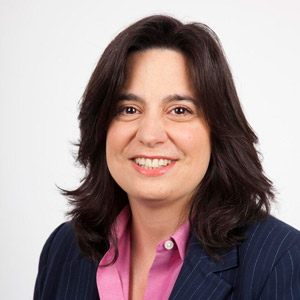New College of Communication Dean Is Scientific American Editor-in-Chief
Mariette DiChristina (COM’86) broke ground as first woman to helm historic publication, led its digital transformation

Mariette DiChristina created her own magazines about science and nature as a girl growing up in Westchester County, N.Y., hand drawing and writing stories about neighborhood wildlife, stapling pages together, and reading them to a captive audience of her two younger sisters.
For almost 20 years, DiChristina (COM’86) has mixed science and journalism on a much grander scale, first as the executive editor and since 2009 as the editor-in-chief of Scientific American.
And now she’s poised to write the next chapter in a distinguished career as the new dean of the Boston University College of Communication. Beginning August 15, she’ll oversee 83 full-time and 107 part-time faculty, 45 staffers, and more than 2,600 undergraduate and graduate students in advertising, communication, emerging media, film and television, journalism, media science, and public relations.
“To me it’s always been a huge joy learning something new and sharing it,” says DiChristina. “When someone else’s eyes light up and you see they got some joy out of the learning as well, it’s just magical.”
The first woman to lead Scientific American, a globally respected publication since its founding in 1845, DiChristina is also the executive vice president of its parent company, Springer Nature, overseeing the journal Nature and related titles.
“Mariette is among the nation’s most accomplished science journalists, editors, and managers,” Jean Morrison, University provost and chief academic officer, said in announcing the appointment June 6. “Throughout the search process, it was evident to all who interacted with her that Mariette’s strong track record of energetic and strategic leadership, her intellectual curiosity and embrace of technological innovation, and her reputation as a gifted mentor and administrator capable of guiding large organizations forward through collaboration and adaptability are an ideal fit for the needs of the College of Communication.”
DiChristina follows two-time Pulitzer winner Thomas Fiedler (COM’71), who is leaving BU after 11 years to join the presidential campaign of Senator Cory Booker (D-N.J.). He will stay on until DiChristina arrives in August.
Challenges await DiChristina, especially in her own undergraduate major, journalism, with traditional media decimated by digital outlets and social media, and all of them under fire amid a rising “fake news” culture.
“The whole world has been transformed digitally, not just journalism but every single dimension of our everyday lives, and we are all going to have to work together to find the best paths through,” DiChristina says. “Students these days will continue to need to be entrepreneurial in their thinking, and what I hope we would give them are the skills they need in critical thinking and professional practice so they can create their own career adventures, just as I’ve done in my life.”
In her larger role at Springer Nature, she notes, her work connects with other programs at COM, including public relations, advertising, media research, and branded content, and she will continue to learn once she arrives, just as she did the first time around.
“Attending BU myself in the 1980s literally changed my life,” says DiChristina, a previous winner of COM’s Distinguished Alumni Award. “A professor there pointed out to me that I had talent when it came to journalism, and he saw in me something that I hadn’t as a 19-year-old had the ability to see myself. It put me on a path that led to an amazing career, where I’ve gotten a chance to learn so many things. But all the things that I’ve learned feel to me like prerequisites for the next course.”
That professor was James Brann, a COM journalism professor emeritus and onetime journalism department chair. She says Brann suggested that she apply for the dean’s job, which she describes as “one of the most important jobs I can imagine: being part of a team of faculty and staff whose goal is to support curious young minds and give them the critical thinking tools and other skills that they will need to create a better future for us all.”
DiChristina has been both editor-in-chief and senior vice president of Scientific American since 2009, winning a National Magazine Award and increasing digital traffic by more than 500 percent. In 2015, she became executive vice president, editorial and publishing, of Springer Nature, leading the 160-person team and overseeing the Scientific American and Nature brands, custom content, and services for clients, business development, and project management.

“The magazine turns 175 next year, yet it is new every hour of every day on its website, social media, and other digital platforms,” says DiChristina, an active Twitter user with 21,000 followers. “I’ve felt the responsibility of stewardship of the brand—and also the joy and the commitment to keep evolving it to stay fresh and relevant for audiences today.”
More than 200 Nobel Prize winners have written for Scientific American, and DiChristina has edited some of them.
As for being the first woman to lead the magazine, she says that one of her then-young daughters summed it up best: “Well, Mommy, obviously people need someone to look up to.”
“It was so simple that a child could see it, yet I had not,” DiChristina says. “This wasn’t really about me and how I felt, but about everyone around me and how they felt. Obviously, we all need to see someone like ourselves in any leadership team. It shows us that we can be a part of that leadership community. It shows us we have the chance to get there as managers, if only we apply ourselves and work hard for it. It shows us there’s hope.”
DiChristina first put her BS in journalism to work as a reporter for small Gannett-owned papers in Westchester, and moved on to Popular Science, where she rose from copy editor to executive editor. She was president of the National Association of Science Writers in 2009–2010. She will contribute to Scientific American occasionally after she joins COM.
Although both she and Fiedler are journalists, search committee chair Paul Schneider, a COM professor of the practice and film and television chair, says that wasn’t why she was chosen from a strong group of finalists who each met with faculty, staff, and administrators. “She’s an outstandingly successful person, and she’s done a great job at Scientific American,” Schneider says. “Everything she’s done, she’s done really well. And she made a really good impression on the people here.”
Her professional involvement extends to other corners at the intersection of science, journalism, and new technology. DiChristina spoke to BU Today from Washington, D.C., where she was attending a workshop she’d helped organize for the Climate Communications Initiative of the US National Academies of Science, Engineering, and Medicine. She organized and moderated Springer Nature’s latest Science on the Hill panel on June 6, discussing ways to solve the plastic waste problem before members of Congress at the Rayburn House Office Building. She is also chair of the Emerging Technologies Council of the World Economic Forum and participates in its Davos conferences, including the “Summer Davos” in Dalian, China.
She will also serve as chief judge for the Google Science Fair, a competition for 13- to 18-year-old students around the world.
DiChristina and her husband live in Pleasantville, N.Y., and have two daughters, one a 2018 CFA graduate with a degree in graphic design. And she’ll soon move to a place near the apartment where she lived for two of her years as a Terrier, on Euston Street in Brookline.
Editor’s note: Due to an editing error, an earlier version of this story incorrectly described DiChristina as the first female dean of the College of Communication. Donis Dondis held that post from 1978 to 1982.

Comments & Discussion
Boston University moderates comments to facilitate an informed, substantive, civil conversation. Abusive, profane, self-promotional, misleading, incoherent or off-topic comments will be rejected. Moderators are staffed during regular business hours (EST) and can only accept comments written in English. Statistics or facts must include a citation or a link to the citation.